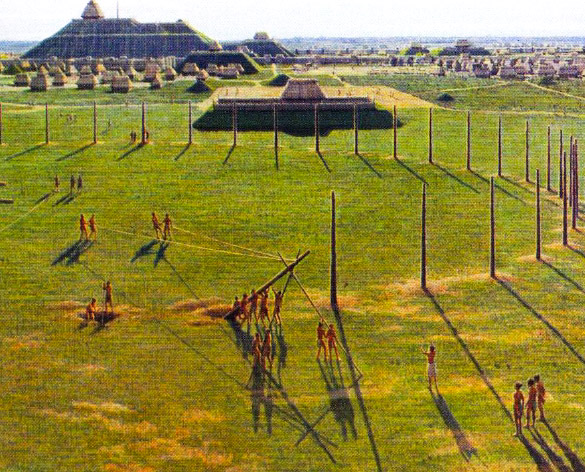Saturday mornings at the Durand Library
By Barbara Flores

SUBMITTED PHOTO The Gazette
Mark Peterson brought Cahokia to life for patrons at his March 9 presentation at the Durand Library. This Native American metropolis at one time had a population greater than the city of London with residents in the tens of thousands, and constructed something that we now call “Woodhenge,” of which archeologists conception of the construction is depicted here.
Cahokia, once a vibrant city
Something happens when we hear a really good presentation about a place. All of a sudden that place comes alive, even one that has been dead for several hundred years. That’s how Mark Peterson brought Cahokia to life for the nearly 20 people at his presentation March 9 at the library.
Cahokia Mounds State Historic Site, a UNESCO World Heritage Site, is the location of a pre-Columbian Native American city which lies directly across the Mississippi River from present-day St. Louis, Missouri. It developed and thrived during the Mississippian Period from 800 to 1400. This Native American metropolis at one time had a population greater than the city of London with residents in the tens of thousands.
Peterson showed a beautiful array of images, which will be sent in PDF form to all those in attendance. The maps, diagrams and images were eye-openers to understanding how the residents lived. They were well aware of the passage of the seasons and had constructed what is called “Woodhenge,” a large circular area defined by upright cedar logs that aligned with the solstice and equinox celestial movements.
But what are the “mounds?” What purpose did they serve? After all, it is a lot of work to move the amount of soil which forms Monk’s Mound, the largest prehistoric earthen structure in the New World. It is named for the Trappist Monks who lived nearby and gardened its lower area. Constructed in 14 stages, it covers more than 12 acres and rises in four terraces to a height of more than 90 feet high. It is termed a platform mound, essentially a stage, where important figures could perform rituals such as summoning the sun.
Traveling only on foot or by boat, the Cahokians traded hundreds of miles from their home. Peterson’s maps showed the widespread areas included in the trade. And people will be people – they found time to play a sport called “chunkey,” which involved sending a hockey puck shaped stone rolling while competitors tried to plant their spear at the point where the stone would fall.
As the largest pre-Columbian site north of Mexico, Cahokia Mounds covered about 4,000 acres and included at least 120 earthen mounds. Illinois now protects 2,200 acres of the central portion of the site and 72 of the 80 remaining mounds.
There are several theories about how this apparently thriving area just slowly but steadily declined. A cold spell, which was hitting Europe in that time period, could have affected agriculture and resulted in a shortage of food, which would have had a significant impact on the concentrated population. Perhaps even more damaging, the people could lose confidence in their leader, that godlike figure who controlled the sun. This loss of faith could have unsettled and disrupted the entire community. In fact, Aztalan in Wisconsin, which is closely tied to Cahokia through trade, also diminished in the same time period.
Durand Library has several books on Native American history and culture. To learn more about these first peoples to inhabit North America, please visit and check out one or more of these books.
Upcoming program
Please take note, as well, of the upcoming Native Plants program on Saturday, March 23, at 10 a.m. Master Gardener Julie Thomas will present about the importance of using native plants in yards and the rewards which will follow, both for the gardener and the butterflies and birds that visit.
About Durand Library
The Durand Library is a collaboration between the Durand School and the Friends of the Durand Library. The volunteer group maintains public hours on Saturday mornings from 9 a.m. to noon, when residents of the school district can check out books and take advantage of the Interlibrary Loan System.
Please enter the school from the east, or playground, end and follow the signs along the wide paved walkway. For more information about the library or its services, please email [email protected], call 815-289-8602, or visit their Facebook page at Facebook.com/DurandVillageLibrary.



